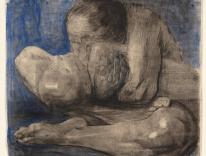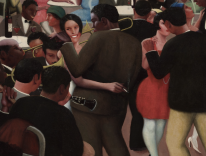It does not take long for "Anselm Kiefer: Works on Paper, 1969-93"-fifty-four watercolors, gouaches, woodcuts, acrylics, and photomontages on exhibit at the Metropolitan Museum of Art until March 21-to rattle and disturb you. It is as if the German artist (born 1945) has set out to wrestle with all your perspectives and preconceptions: intellectual, aesthetic, and moral.
First there is the bracing Nordic coldness of many of the representations; then the brashness of artistic manner, at times suggesting a lack of finesse if not flakiness; and finally an insistent intellectualism that cries out for explication. One doesn’t ordinarily anticipate finding the name Ludwig Feuerbach scrawled across an otherwise scenic and well-executed watercolor ("German Lineage of Salvation," 1975). Here, as elsewhere in the exhibit, curator Nan Rosenthal’s explanatory notes are invaluable, for Kiefer seems intent on taking you deep into the Teutonic forest. He dwells not only on Germanic mythologies, art, and philosophy, but on National Socialism, the Holocaust, and nuclear Armageddon.
Kiefer was born in Baden-Wurtemburg, on the upper Rhine, the son of an art teacher. While at university, he studied law and French but, after a retreat at the Dominican priory at La Tourette, decided to pursue art. He is best known for his large, layered, abstract yet representational canvases of ruins, forests, and fields, one of which, the majestic oil piece "Bohemia Lies by the Sea" (1996), is adjacent to the entrance of this exhibit. The horizon figures prominently in many of his works. In 1992 he moved to southern France, where he maintains a studio in Barjac.
This collection consists of the Met’s impressive holdings of Kiefer’s works on paper and a huge woodblock arrangement attributed to Albrecht Dürer, on loan for the occasion from Washington’s National Gallery of Art, that helps place Kiefer in perspective. Kiefer is at home in a wide variety of mediums, and here displays them individually (as in a number of lucent watercolors) or combines them, using photographs, acrylic, molten lead, even straw or debris to convey a sense of both limits crossed and materiality. Scholar Mark Taylor has remarked that despite Kiefer’s penchant for interfacing genres and uncommon elements, his works are not incoherent, "although they may not form readily integrated pieces" (Disfiguring, University of Chicago Press). According to Taylor, by utilizing a variety of artistic elements, philosophical themes, and symbolic metaphors-in the Met exhibit, serpents are prominent, as are wood, fire, Nazi architecture and paraphernalia, even the artist’s palette-Kiefer forces the viewer to contemplate the complex, harrowing events of the century.
Perhaps there is no more apparent example in this exhibit than the fine "Winter Landscape," 1970 (see cover), a seventeen-by-fourteen-inch watercolor, gouache, and pencil work. A woman’s head, thrown back and bleeding profusely from the neck, floats out of a descending cloud and drips blood onto a pocked, snowy field. It is a powerful visual image, evoking Nelly Sachs’s poem, O die Schornsteine:
O the chimneys
On the ingeniously devised habitations of death
When Israel’s body drifted as smoke
Through the air.
The Shoah is never far from Kiefer’s mind. As he commented in 1990: "We see railroad tracks anywhere and think about Auschwitz. It will remain that way in the long run." According to the critic and novelist Francine Prose, Kiefer’s artistic project involves nothing less than redeeming his country by making the viewer look hard at images that evoke Germany’s past and present.
Kiefer’s 1985 work, "Heavy Cloud," utilizes the same horizontal perspective, but this time the hovering cloud has been formed literally out of molten lead. Superimposed on a photograph of a descending ridgeline, this "heavy-water" cloud leaks a stream of yellow radiation onto the landscape below. Heavy water, of course, is an element in the nuclear process, and at the time of the work’s composition, nuclear safety and NATO’s plan to extend medium-range missiles on German soil were hotly contested issues. Never adverse to irony, Kiefer employs lead-an element used to store nuclear materials-to depict a rather porous container. There are even patches in the lead cloud where acid has eaten through, exposing the back of the piece. Taylor comments that Kiefer’s art is "rending," that such rifts are left uncovered to startle the viewer into realizing just how disfigured and disjointed are our times. Kiefer himself has said: "I tell stories in my pictures...to show what’s behind the story. I make a hole and go through."
Kiefer deploys irony elsewhere when he uses Nazi symbols to deprecate them. "Untitled (Heroic Symbols)," 1969, is a watercolor self-portrait. The artist raises a Sieg Heil salute in a bleak landscape, but all the grandiosity of Hitler’s "thousand-year Reich" is made impotent in his limp-wristed hand.
In "On the Rhine" (1987), a huge, roughly hewn, twelve-by-fourteen-foot composite woodcut and acrylic, there is another cloud of sorts, a chorus of witnesses hovering above the horizon formed by the Rhine. The river flows serenely, left to right; on its near side is a burning pyre. Perhaps it signifies the destruction let loose by German history. The cloud is composed of nineteen woodblock portraits, fused to form a pantheon of German literary, philosophic, and military personages. They include Saint Ludmila, Alfred Krupp, Clausewitz, Nazi storm trooper Horst Wessel, Heidegger, and the composer Carl Maria von Weber. A decidedly mixed crowd. In using the art of the woodcut, Kiefer indicates his respect for German high culture and tradition, but pokes a finger at its false impulses and catastrophic deeds.
The final piece in the exhibit, "Untitled" (1996), is another large (twelve-feet-by-eight) composite woodcut that uses acrylic and shellac on paper and canvas. In stark black and white, it depicts the sleeping artist on the floor of a field of gigantic black sunflowers. A shaft of the mammoth flowers seems to rise out of his lower body, swaying totem-like over his frame. Light seems to emanate from the darkness here. Bits of shellac, splattered high up on the screen à la Pollock, send fleeting glints of light onto the forest floor, rejuvenating life. Despite the century’s terrors, we are not undone.
Anselm Kiefer’s work is neither seamless nor reassuring. Precisely for those reasons, one cannot turn from it unchallenged or unmoved. As befits the work of a powerful first-generation postwar German artist, it combines elements of self-reproach, agonizing memory, and the need to engage them while moving on.
Please email comments to [email protected] and join the conversation on our Facebook page.
Previous Story
'Kristallnacht' Remembered
Next Story
Elegy for Iris


